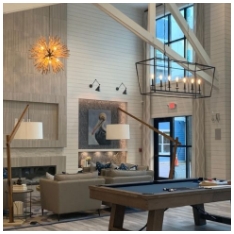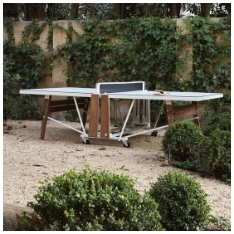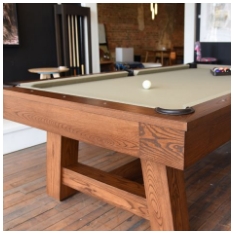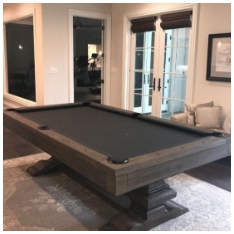Selecting the right slate thickness is one of the most important decisions when buying a pool table. While design, size, and finish all play a role in the overall experience, the slate—the bed beneath the felt is what ensures a level playing surface and consistent ball roll. This article covers everything you need to know about choosing the right slate thickness for your pool table, including available options, pros and cons, and practical considerations for long-term use.
What Is Slate in a Pool Table?
Slate is a fine-grained rock that is cut and leveled to form the base of a pool table. It serves as the foundation for the playing surface and supports the felt covering. Due to its density and ability to remain flat over time, slate is the preferred material for high-quality pool tables.
Slate comes in varying thicknesses and is typically available in:
- ¾ inch (19 mm)
- 1 inch (25 mm)
- 1¼ inch (30 mm)
The thickness you choose will impact gameplay, table durability, and weight, which in turn influences table setup and maintenance.
Common Slate Thickness Options
¾-Inch Slate
This is the minimum slate thickness found in entry-level or recreational pool tables. While more affordable, it often lacks the rigidity and levelness needed for serious play.
Pros:
- Lower cost
- Lighter weight (easier to move)
Cons:
- More susceptible to warping over time
- May require more frequent leveling
- Less stable playing surface
1-Inch Slate
This is the standard slate thickness for most home and commercial pool tables. It balances weight and performance well, offering a reliable playing surface for casual and competitive players alike.
Pros:
- Industry-standard thickness
- Provides good stability
- Approved for tournament play by many pool organizations
Cons:
- Heavier than ¾-inch options
- Requires solid floor support for proper installation
1¼-Inch Slate
This thickness is typically used in premium or professional-grade pool tables. While it provides the most solid and level surface, it also adds significant weight.
Pros:
- Excellent durability
- Optimal flatness and consistency
- Superior resistance to environmental changes
Cons:
- Expensive
- Very heavy and difficult to move

Why Slate Thickness Matters
Playing Surface Quality
The most obvious impact of slate thickness is on the flatness of the playing surface. Thicker slate is more resistant to warping and imperfections, which leads to more accurate ball movement.
Structural Integrity
A thicker slate increases the overall weight of the table, which improves its stability. A pool table that stays firmly in place during gameplay enhances both the feel and reliability of shots.
Long-Term Durability
Thicker slate lasts longer and is less affected by environmental changes like humidity and temperature fluctuations. If you plan to keep your table for many years, choosing a thicker slate can reduce long-term maintenance needs.
One-Piece vs. Three-Piece Slate: A Related Consideration
In addition to thickness, slate also comes in one-piece or three-piece designs. Thinner slates are often one-piece, while thicker slates are more commonly divided into three pieces.
One-Piece Slate
Best suited for smaller spaces or budget tables, but harder to level perfectly due to its size.
Three-Piece Slate
Easier to level during installation and more commonly found in tables with 1-inch or thicker slate. These are better suited for serious players who want precision.
Factors to Consider When Choosing Slate Thickness
Intended Use
If the pool table is for casual family use, a ¾-inch slate might suffice. However, if it's intended for regular practice or competitive play, 1-inch or 1¼-inch is recommended.
Budget
Thicker slate increases the table’s price, not just due to the material cost but also because of the added construction support needed for the frame and legs.
Floor Strength
A thicker slate significantly increases the weight of the pool table. Make sure the floor in your space can support the added weight, particularly for older homes or second-story rooms.
Transport and Installation
Moving a table with thicker slate is more challenging and typically requires professional help. It’s important to factor in these logistics when deciding.
Slate Thickness and Table Size: Finding the Right Match
Larger pool tables, such as 8-foot or 9-foot models, benefit more from thicker slate due to the increased surface area. A 1-inch slate ensures the table remains flat and stable across its entire span. Smaller tables, such as 6-foot or 7-foot models, may not require the same level of thickness, especially for light recreational use.
Installation Tips for Optimal Performance
- Leveling: Professional installation ensures the slate pieces are aligned and leveled properly, which is essential regardless of thickness.
- Seaming: If using a three-piece slate, the seams must be filled and smoothed to ensure consistent ball roll.
- Framing: Make sure the table’s frame is built to handle the slate’s weight. A poorly supported slate, even if thick, can still result in an uneven playing surface.
Conclusion: Making the Right Slate Thickness Choice
When it comes to choosing the right slate thickness for your pool table, there is no one-size-fits-all answer. Your decision should reflect how often you’ll use the table, what level of play you expect, the space you have, and your budget.
For most homes, a 1-inch slate offers the best combination of performance and durability. If you’re looking for tournament-level play or long-term investment, consider going with a 1¼-inch slate. On the other hand, if you're buying a table mainly for light recreational use and cost is a concern, a ¾-inch slate can serve its purpose with proper care.
Investing time in choosing the correct slate thickness ensures that your pool table delivers a consistent and enjoyable playing experience for years to come





